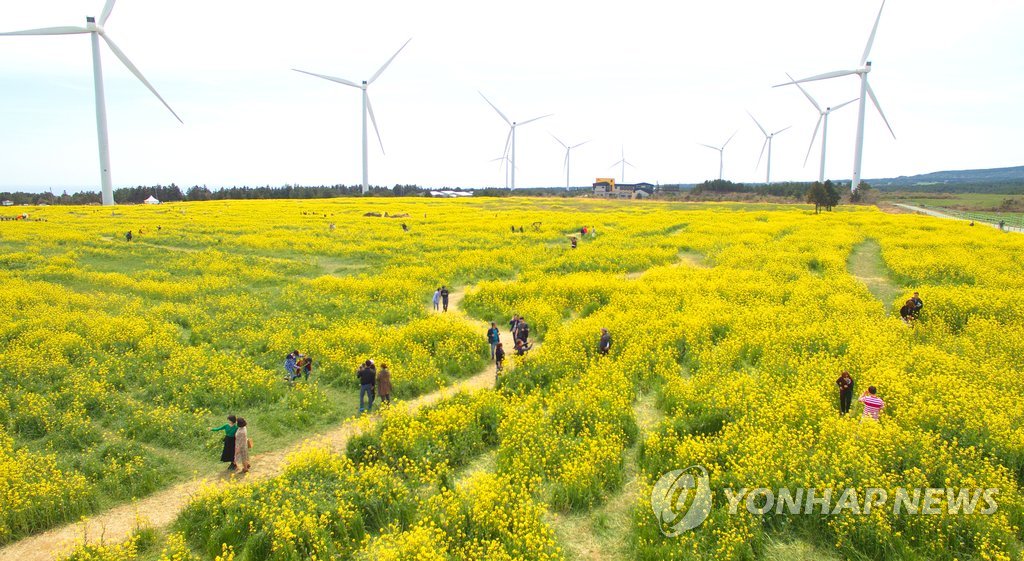Ministry of Industry announces’Regional-led measures to activate distributed energy
Won Hee-ryong’s Jeju branch, suggests designation of a special distributed energy zone and liberalization of electricity transactions
(Seoul·Jeju = Yonhap News) Reporter Cho Jae-young and Go Seong-sik = The government has decided to transfer the remaining renewable energy power to the land in Jeju Island. Because of the over-produced electricity, it is often necessary to stop the renewable energy generator.

(Jeju = Yonhap News) Reporter Park Ji-ho = Minister of Trade, Industry and Energy Sung Yun-mo (ninth from the left) and Jeju Governor Won Hee-ryong (left Eighth) and others are taking commemorative photos. 2021.3.3 [email protected]
On the 3rd, the Ministry of Trade, Industry and Energy announced a’regional-led measures to revitalize distributed energy, including measures to minimize renewable energy output control in Jeju Island’ at the New and Renewable Energy Promotion Center in Jeju Island.
Distributed energy refers to energy that is produced in a place where demand is needed, such as small and medium-sized renewable energy, combined heat and power generation, self-generation, and energy storage (ESS), and consumed in that area.
In Jeju Island, which is currently pursuing the’carbon free island (carbon-free island) 2030′ policy, it is urgent to solve the problem of excessive production of renewable energy power. The share of renewable energy output in Jeju Island increased from 9.3% in 2016 to 16.2% last year.
The problem is that the generation of wind power and the like is causing excessive supply of electricity than demand, so it is increasingly necessary to stop the generator forcibly. A power outage occurs even if the power is insufficient, but an overload can cause a power outage due to overloading of the power system. The number of output controls to prevent this increased from 3 in 2015 to 77 last year.
Accordingly, the government decided to send surplus power in Jeju Island to land through two lines of submarine cables (HVDC, high voltage direct current transmission) between Jeju and land.
Previously, electricity was sent only to Jeju Island from land, but the plan is to secure reverse transmission capability and transmit power in the opposite direction. In this case, the renewable energy capacity in the province will increase to a maximum of 342MW, the Ministry of Industry predicted.
Furthermore, when a third submarine cable capable of real-time two-way transmission is completed at the end of 2022 according to the power supply and demand situation between Jeju and land, 400MW of renewable energy capacity in the province will be added.

[연합뉴스 자료 사진]
In addition, the government decided to first build 23MWh of’system stabilization ESS’ from Jeju Island this year to alleviate volatility in renewable energy.
The technology to convert surplus renewable energy into hydrogen (P2G: Power to Gas) or heat energy through an electric boiler (P2H), and technology that utilizes electric vehicle batteries like ESS (V2G) are also demonstrated in Jeju Island.
The’plus DR system’, which provides incentives when excess power is consumed, will be introduced in Jeju Island from this month.
In addition, a customized micro grid project will be promoted so that a variety of energy systems can be built by reflecting regional characteristics.
An official from the Ministry of Industry said, “The Woncheon Village in Hongseong-gun, Chungnam, converts livestock manure into biogas to produce energy and consume it in the vicinity.”
In addition, regions with a high proportion of distributed energy will be designated as special distributed energy zones to allow special cases for power transactions such as the disappearance of integrated power plants and direct transactions between producers and consumers.
The government has only proposed measures for the Jeju area this time, but is planning to release a’roadmap for activating distributed energy,’ which comprehensively contains the directions for mid- to long-term institutional improvement in the first half of the year.
Minister of Trade, Industry and Energy Sung Yun-mo said in a greeting at the presentation, “We need to establish a system for activating distributed energy and change energy infrastructure in an eco-friendly direction. We will minimize the control of renewable energy output in the future.”
Jeju Governor Won Hee-ryong suggested that Jeju be designated as the nation’s No. 1 Distributed Energy Special Zone, saying, “Jeju will go beyond energy independence and make a success case as an eco-friendly island based on clean energy.”
Governor Won also said, “We will work out the trial operation of the power transaction liberalization system by closely discussing with the government.”
Currently, electricity producers can only sell electricity through the transmission and distribution lines of KEPCO, but if electricity trade is liberalized, electricity can be bought and sold without going through KEPCO.
Unauthorized reproduction-prohibition of redistribution>
2021/03/03 16:57 sent
